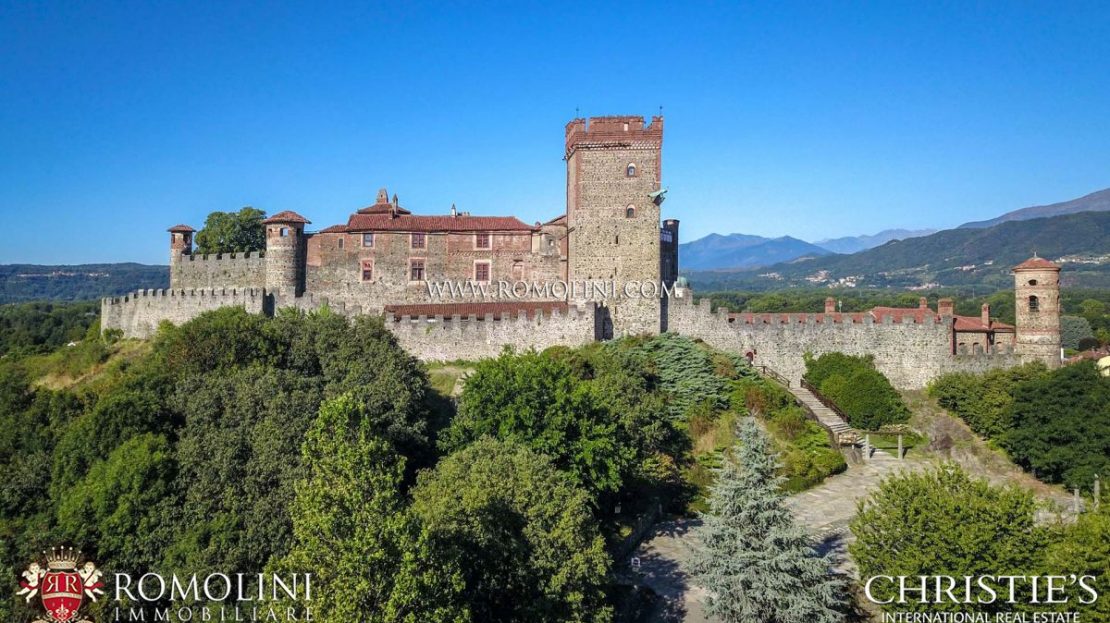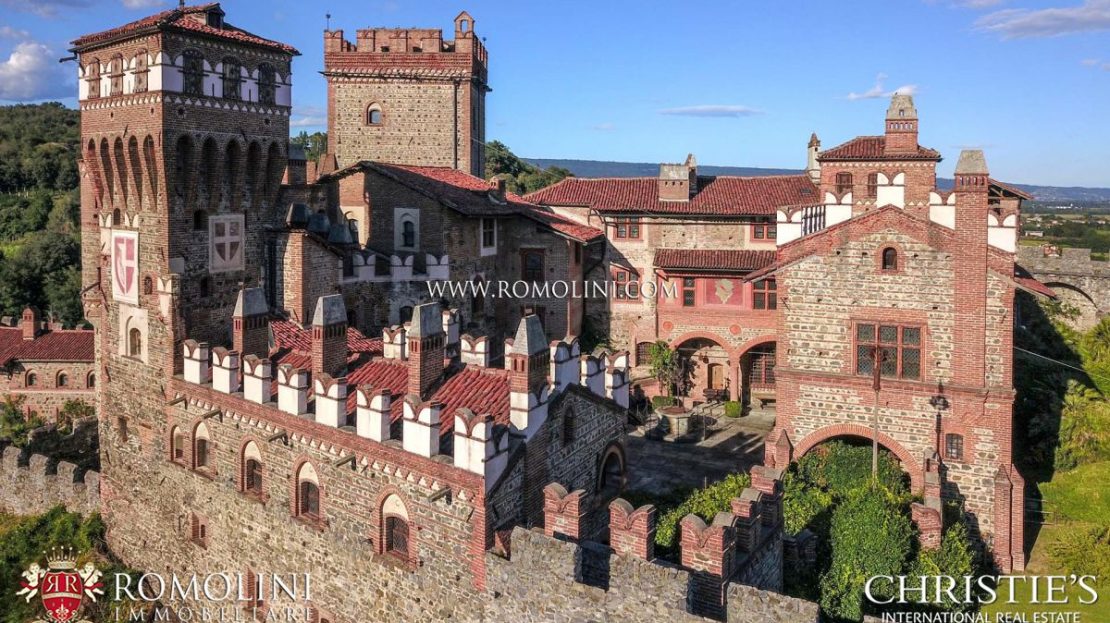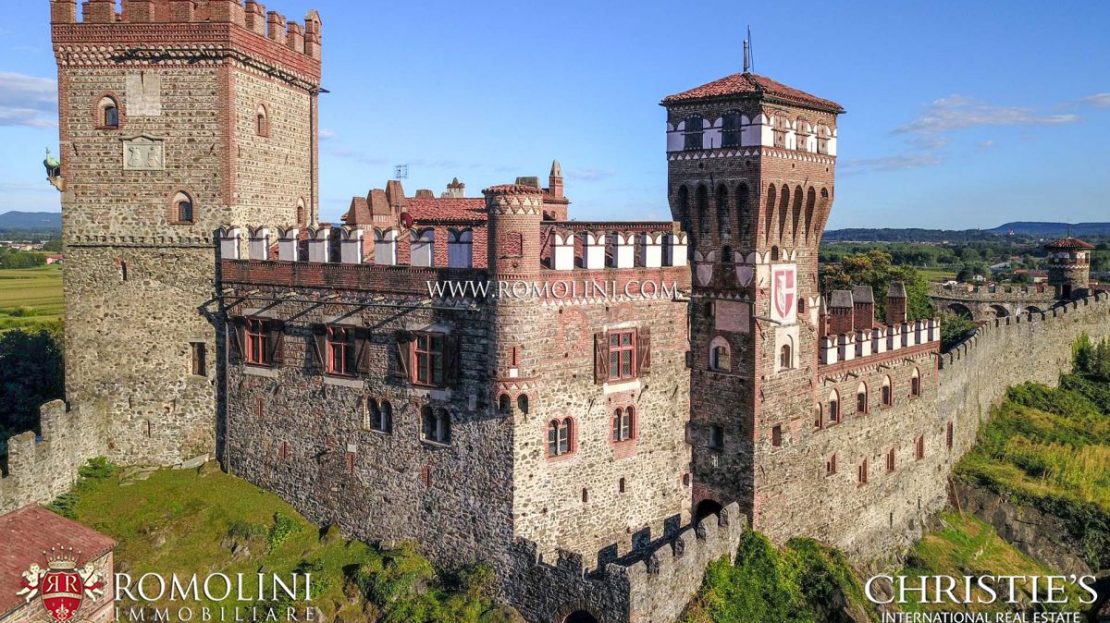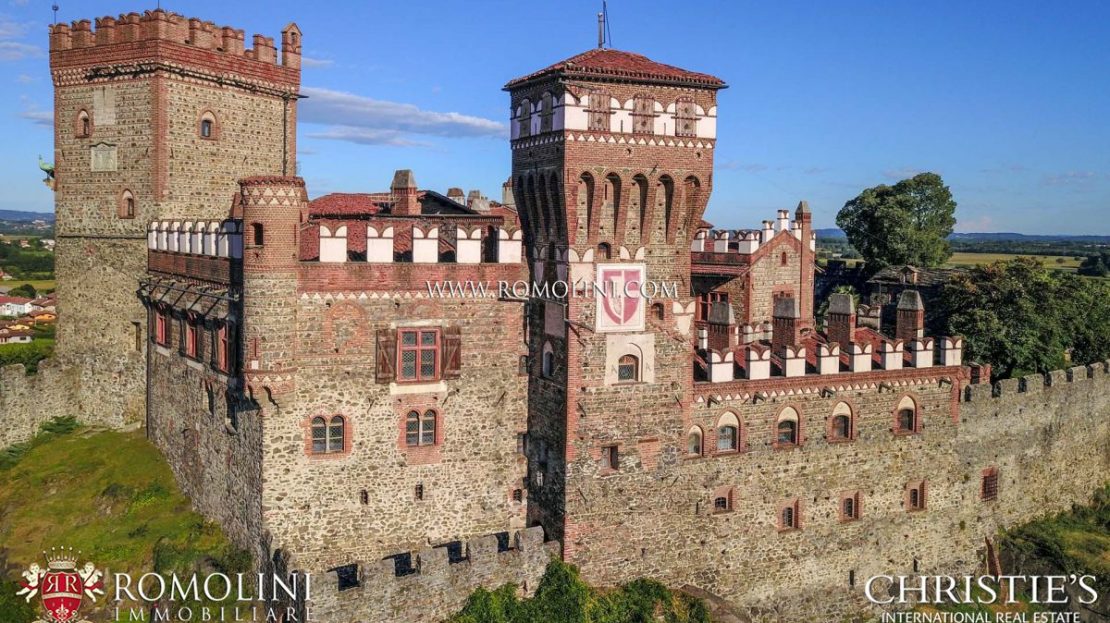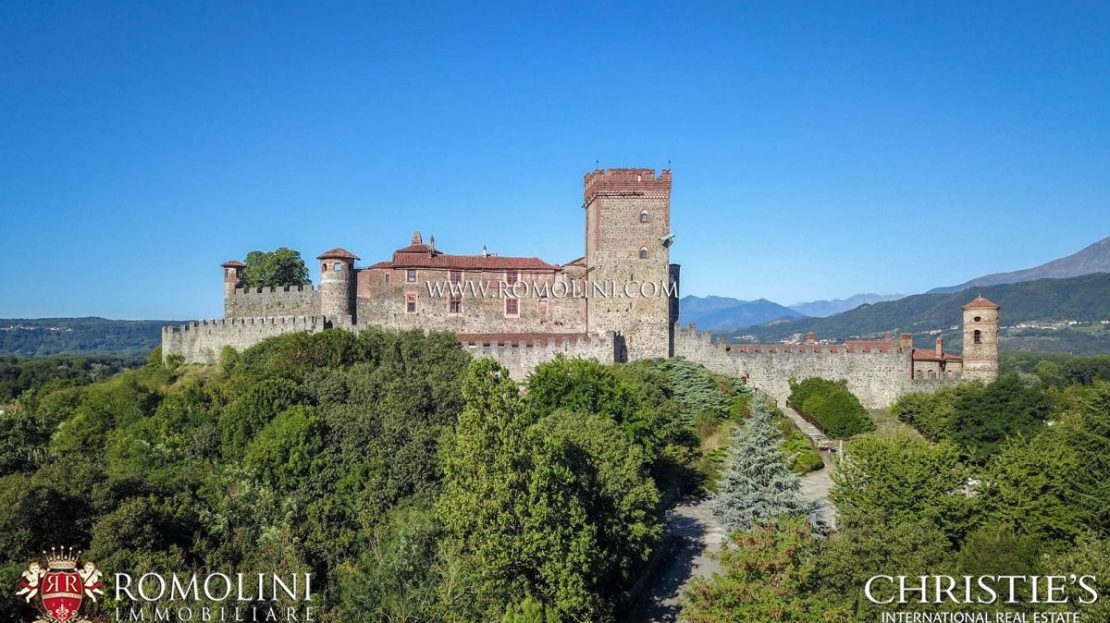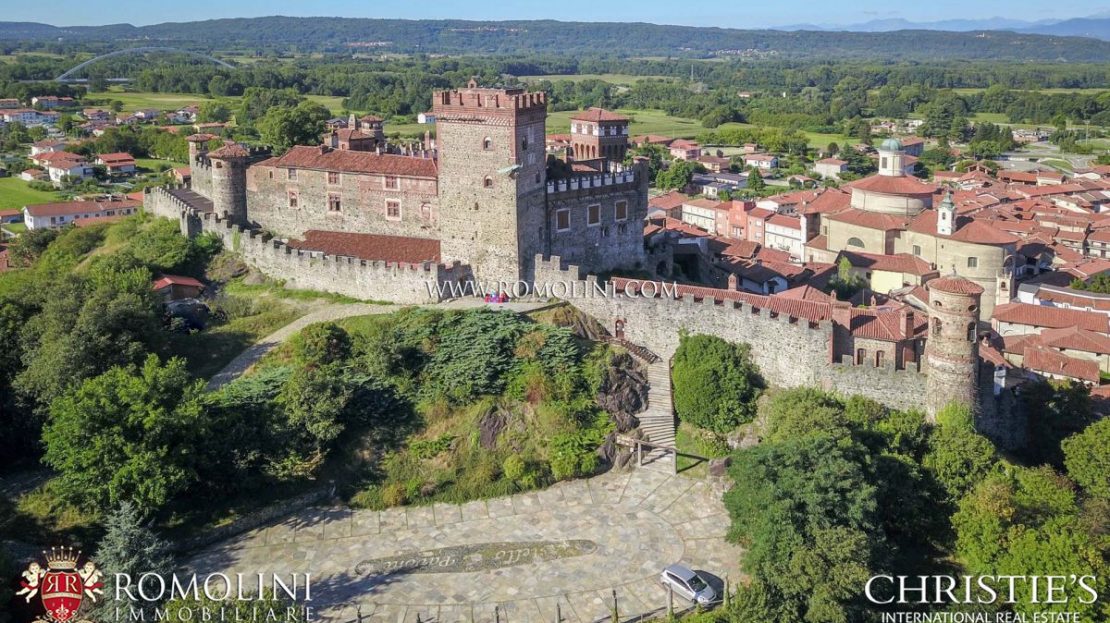CASTLE FOR SALE IN ITALY, LUXURY 5-STAR HOTEL PIEDMONT
Description
CASTLE FOR SALE IN ITALY, LUXURY 5-STAR HOTEL PIEDMONT
The castle, the only one to have a 7-page article on the Encyclopedia of Italian castles, is located on top of a hill overlooking a characteristic historic center of Piedmont.
The building was masterfully restored and converted into a luxury 28-bedroom hotel. In a very panoramic position, this spectacular castle is also the ideal location for weddings, ceremonies and congresses thanks to a set of beautiful conference halls (up to 250 seats) and a welcoming restaurant (400 seats) offering typical Piedmontese dishes and international cuisine. The building, thanks to an exceptional restoration with this precise aim, is also perfect both as a private residence and as a luxury representative seat for a company.
The town, located just 600 m from the Ivrea highway junction, is just below the castle. Other towns of Northern Italy are no more than two hours away by car (Ivrea, Biella, Turin, Casale Monferrato, Asti, Milan, Alba, Como, Genoa…).
The closest airport is the one in Turin (53km; 40’) but the terminals in Milan, Cuneo and Genoa are easily reached as well.
DESCRIPTION OF THE BUILDINGS
The medieval castle covers a surface of approximately 4,000 sqm which includes 65 among halls, sitting rooms, 28 bedrooms, an ample professional kitchen (140 sqm – 1,506 sqft), offices, reception and 42 beautiful bathrooms which follow the style of the castle. The building features harmonious and fascinating lines testifying a series of reconstructions and expansions over the centuries. Among the rooms, several beautiful halls and conference rooms can accommodate up to 250 guests.
One of the halls inside the castle is reserved for the Museo d’Andrade, which cannot be separated from the building considering the deep link between the castle and the architect. The exhibit includes Greek and Mycenaean pottery, several medieval artifacts, a Greek shield, Neolithic flints and several other interesting pieces.
In the typical medieval park, right in the middle of the garden, there is a beautiful 9th-century church (50 sqm – 538 sqft) which includes two original Roman tombs dating back to the 5th and 4th century BC. Inside the church, one can also pay homage to the mortal remains of Alfonso de Andrade and his wife Costanza.
The castle is then completed by several annexes, warehouses and technical rooms (210 sqm – 2,260 sqft) and two cozy townhouses (115 sqm – 1,237 sqft) located right in the town.
STATE AND FINISHES
The castle was masterfully restored in recent years: after the works carried out by Alfredo de Andrade at the end of the 19th century, the castle has been in the possession of a company owned by the Giodice family who, with a great renovation, converted the building initially into a representative seat for their pharmaceutics company and then into an exclusive hotel with restaurant and conference halls.
Current owners have invested a great deal of money to update the building adding all the necessary systems (thermal, air conditioning, hydraulic, electrical, sewage…) without however altering the most interesting and appealing elements of the castle (its stone walls, the beautiful wooden ceilings, frescoes, original fireplaces…), all of which have been restored and brought back to their original splendor.
All the rooms are heated and equipped with one or more phone plugs.
Even the outdoor garden has been carefully landscaped so it can offer the guests of the hotel a unique and pleasant relaxation opportunity, while also making it ideal for events and weddings.
HISTORY OF THE CASTLE
The area around Pavone was inhabited since the Bronze Age and many documents prove its existence under the Roman Empire as a small vicus (or, more probably, a castrum). True development came with the Middle Ages, since the village was located along a fundamental road connecting Ivrea and Turin.
In such a dangerous period (around the 10th century), following the fall of Rome, with Germanic peoples ravaging Italy, the citizen of Pavone decided to enclose St. Peter’s Church (built in 859 AD) with walls (over 5 m tall in certain spots) creating a first fortified refuge which was subsequently expanded to improve its defenses.
In 990 AD, Otto III of the Holy Roman Empire conceded the Canavese and the surrounding territories to marquis Arduin of Ivrea, by many considered the first King of Italy.
After years of contention with local bishops, Arduin marched against Vercelli, conquering the city and destroying the cathedral. The bishop Peter died in the event and Pope Sylvester II was forced to intervene, excommunicating both Arduin and his son.
The papal intervention was unsuccessful in stopping Arduin who, while no longer supported by Otto III, kept fighting his war, an event commonly known as the Anscarid rebellion.
Intervening in Italy, the emperor defeated Arduin (who temporarily fled to Burgundy) and on July 9, 1000 he produced a diploma to assign the now-confiscated lands to bishop Warmund of Ivrea. Other territories were taken from the Aleramici and gifted to marquis Olderico Manfredi.
The bishops and his successors quickly opted to build a huge fortified tower (technically named donjon) just outside the existing walls and over the following centuries new sections were added to what had by then become a tout-court fortified castle with a manorial look on the inside. In the mid-14th century a new wing was added to the north and a thorough restoration was carried out on the round bastions along the walls.
In the years of the Bishopric the legend of the “lucky castle” was born: the building was, in fact, a refuge for bishops fleeing the wrath of the poor citizens. To this end, a narrow tunnel was dug in great secrecy through the granite mountain to allow the residents of the castle to flee unseen.
This fame of “lucky castle” was further reinforced by the fact that the building was never actually conquered with arms despite its long history.
The castle, through a series of events, ended up in the hands of the noble Savoy family, whose coat of arms is still nowadays well visible on the tower guarding the entrance. With the establishment of the Kingdom of Italy, the castle remained in the possessions of the Royal Family until 1885 when Portuguese architect Alfredo de Andrade bought the castle from the government. De Andrade, one of Eugène Viollet-Le-Duc’s greatest admirer and great expert of the Piedmontese Middle Age, the architect behind the Borgo Medievale di Torino (which clearly bears resemblance to both the Castle of Pavone and Fénis), spent his last years restoring the castle to a mostly original state, bringing the interiors back to their original beauty by using carefully selected local artisans. Particularly interesting is the decorated coffered ceiling in the Hall of King Arduin, previously owned by the counts of San Martino di Strambino. When Alfredo died, his son Ruy took the reins of the work and completed the remaining renovations.
During World War II, a German battalion set camp at the feet of the mountain but the commander prevented forbade the soldiers from entering the building: struck by the beauty and charm of the castle, he did everything he could to avoid the building being damaged by fights and/or bombardments.
In 1981 the castle was recognized as a National Monument and ten years later, in 1991, it was finally bought by the current owners who used it as a representative seat for their company before converting into a prestigious and luxurious 4-star hotel capable of bringing its guests back into the Middle Ages, but with all the modern comforts.
EXTERIORS
The castle is enriched by a masterfully maintained 4,500-sqm park with ornamental trees, flowers and palms. The green areas are enclosed by the castle walls and are crossed by stone walkways and staircases leading up to the top of the hill where the main portion of the complex is located.
Finally, enclosed by the second wall and dominated by the towers, right in the middle of the castle, there is a noble courtyard (400 sqm) enriched by a very elegant handcrafted stone paving. Right in the middle of the courtyard is placed the beautiful Mystery Well. This is a unique and magic background for events.
Right outside the castle, under the imposing walls, there is an ample and convenient paved parking lot where guests can leave their car during the stay. Building this apron was a great investment since huge blocks of granite had to be removed to level the ground. The apron is also easily usable as a helipad. Other parking areas and aprons are nonetheless available in the outskirts of the castle.
Two roads lead to the castle: the first one reaches the parking lot and the main entrance of the complex; the second one starts right from the town and leads directly inside the castle.
All around, the property boasts a total of 1.5 hectares of land, covered either in gardens and mixed woodland.
USE AND POTENTIAL USES
The castle, considered one of the most beautiful in Italy, is one of the few where there is no obligation to allow public visits (which would be a condition had the owners taken advantage of state funding): the only restriction is the one concerning National monuments, which is normal considering this is one of the most important castles in Italy.
The building, with its perfectly preserved architecture and its enviable history, has been converted into a luxury hotel with 28 bedrooms. The halls accommodate a sophisticated restaurant with a capacity exceeding 400 guests and ample event and congress rooms and, outside, a beautiful 9th-century church. All these details make the property ideal, other than as a hotel, as a location for weddings and conferences, a private luxury dwelling, or even as a representative seat for prestigious company. There are multiple available paths thanks to the fact that the castle hasn’t been altered in any way during the renovation.
NEAREST TOWNS
Ivrea (5km; 10’), Biella (30km; 45’), Turin (52km; 50’), Vercelli (57km; 40’), Casale Monferrato (77km; 50’), Asti (119km; 1h 20’), Milan (122km; 1h 25’), Alba (126km; 1h 40’), Como (147km; 1h 35’), Genoa (184km; 2h 10’)
NEAREST AIRPORTS
Torino Pertini (53km; 40’), Milano Malpensa (115km; 1h 10’), Milano Linate (138km; 1h 25’), Cuneo Levaldigi (144km; 1h 35’), Genova Colombo (175km; 1h 55’)









